Tanner Springs Park is in the March 2006 issue of Metropolis Magazine

Portland’s Tanner Springs Park in the Pearl District is featured in the “Metropolis Observed” column in the March issue of Metropolis Magazine.
Since attending an introductory presentation at the First Congregational Church a few years ago, I have watched the project with interest as it seeks to reveal a long lost wetland landscape in the middle of a new urban neighborhood. 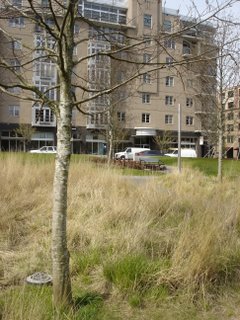 Despite its spatial limitations, the park is remarkably true to the vision described by landscape designer Herbert Dreiseitl in the early presentations.
Despite its spatial limitations, the park is remarkably true to the vision described by landscape designer Herbert Dreiseitl in the early presentations.
The dock might not float as it was hoped and the anticipated frogs have yet to arrive, but by and large the park succeeds as a small contemplative break in the new neighborhoods march towards the river.
 The area around NW 9th and Lovejoy: From the old Lovejoy viaduct in 1995 and street level in 2006.
The area around NW 9th and Lovejoy: From the old Lovejoy viaduct in 1995 and street level in 2006.
North of Lovejoy and east of 13th, the Pearl District overlays the site of the Hoyt Street Yards of the Spokane Portland and Seattle Railway. The neighborhood loses its anchor to former warehouse and industrial district to the south and becomes something entirely new. The area is not without interesting buildings but the overall effect verges towards homogeneity, a Design Within Reach world that begs for variation and surprise. If there is one place on the entire planet that might actually need a McDonalds, this could be it.
The problem might be faced by any neighborhood built new from the ground up. Most of Portland’s successfull revitalized neighborhoods (think Northwest, Belmont, Alberta and Mississippi etc.) had inexpensive older buildings that attracted creative enterprises and varied groups of people. To use a metaphor from the Monopoly board, those neighborhoods started to re-emerge as Baltic and Mediterranean then built themselves up to incorporate aspects of St. Charles Place, then St. James or Illinois Avenue, maybe even Marvin Gardens as they evolved. The north end of the Pearl District has to develop backwards, if not from Boardwalk and Park Place at least from Pennslyvania Avenue. Unless buildings encouraging more diverse groupings of people and uses are built, the upper Pearl will need all the help it can get to be varied and vital.
Tanner Springs Park is a step in the right direction.
 In this 1852 map, Tanner Creek meets the road from the Tualatin Plains west of town, then flows northeast towards Couch Lake and the Willamette River.
In this 1852 map, Tanner Creek meets the road from the Tualatin Plains west of town, then flows northeast towards Couch Lake and the Willamette River.
The park is named for Tanner Creek, which once passed through the area on its way to the Willamette River from the West Hills. Daniel H. Lownsdale, one of the original Portland proprietors built a tannery beside the creek in 1845 near the present PGE Park (where it is rumored the tannery’s vats are still buried). To this day Tanner Creek exists as a subterranean run-off. Tanner Springs Park is located on the site of a long vanished wetland where the seasonal boundaries of Couch Lake, the Willamette River and Tanner Creek met. Captain Couch (whose endorsement of Portland as the head of ocean going navigation on the Willamette River was so important to the city’s early success) shot ducks for his dinner from the porch of his house near where Union Station is today. By the end of the nineteenth century the entire area was filled. Tanner Creek was buried and largely forgotten for the next hundred years.

 The same location, in 1994 and 2006.
The same location, in 1994 and 2006.
Tanner Springs recollects, but does not try to recreate the original landscape. It is still a city park and a small one at that. The upper portion on the west side is conventional lawn. A rainwater fed “spring” sends water in small streams to a pond at the lower end of the park. Native Oaks and grasses are planted between the upper lawn and the water. Recycled cobblestones are used on paths and a fence of old rails from the former Hoyt Street Yard form the park’s east boundary. The water circulates through a hidden reservoir which is filtered by the wetland.  Tanner Spring.
Tanner Spring.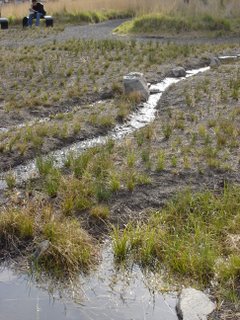
 This year the park will have its first spring. It will be interesting to see if the “wild” areas will become more so. I hope they do.
This year the park will have its first spring. It will be interesting to see if the “wild” areas will become more so. I hope they do.
To some the park is not user friendly enough. Dogs are not allowed. There are no activity areas. It is fragile. It is hardly idiot proof. To others, who hoped for a daylighting of the original Tanner Creek, it does not go far enough to return the wetland to the area.
Within its modest boundaries however, it is a unique and engaging addition to Portland’s parks.
Tanner Springs Park like the neighborhood around it, is an experiment that will not show its final results for years, even decades. How will it look as the grasses grow and the trees get higher? Will the frogs arrive?
It will be interesting to watch.

 The Portland Streetcar passes the park at NW 10th and NW Northrup.
The Portland Streetcar passes the park at NW 10th and NW Northrup.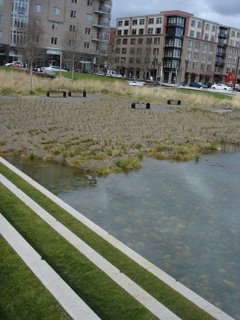

 On the site of Hoyt Street Yard, 2006.
On the site of Hoyt Street Yard, 2006. Spokane, Portland & Seattle Railway's Hoyt Street Yards in the early 1940s. The present location of the park is in the right corner of the photograph.
Spokane, Portland & Seattle Railway's Hoyt Street Yards in the early 1940s. The present location of the park is in the right corner of the photograph.
 In Remembrance of the Lost Wetland" Aritst Herbert Dreiseitl.
In Remembrance of the Lost Wetland" Aritst Herbert Dreiseitl.
The Rip City Curse
 Portland is still trying to figure out Paul Allen’s dramatic act of public relations seppaku. Did he actually believe that a cash strapped and cranky city would offer financial assistance to a losing team with a history of civic embarrassment midway through its worst season ever? Or was it part of a larger strategy with an endgame visible only to him? Does he want to sell the team? Does he want to buy back the Rose Garden? Whatever his motivations, the actual explanation for his actions is far more cryptic and sinister. Paul Allen’s plea for public money is just the latest manifestation of a sports curse of particular power and malevolence.
Portland is still trying to figure out Paul Allen’s dramatic act of public relations seppaku. Did he actually believe that a cash strapped and cranky city would offer financial assistance to a losing team with a history of civic embarrassment midway through its worst season ever? Or was it part of a larger strategy with an endgame visible only to him? Does he want to sell the team? Does he want to buy back the Rose Garden? Whatever his motivations, the actual explanation for his actions is far more cryptic and sinister. Paul Allen’s plea for public money is just the latest manifestation of a sports curse of particular power and malevolence.
Is there anything more terrifying for its random application and sheer reach than a sports curse?
In game 4 of the 1945 World Series, Chicago tavern owner William Sianis bought two tickets, one for him and one for his pet goat, to watch the Chicago Cubs play the Detroit Tigers in Wrigley Field. It was a fine outing for man and goat until they were ejected by order of Cubs owner Philip Knight Wrigley. Mr. Sianis was outraged. He and his goat were crowd favorites. As he was lead from the ballpark he placed a curse on the Chicago Cubs: They would never win another pennant or play in a World Series in Wrigley Field again. Thus was born the Billy Goat Curse.
Like the Curse of the Bambino (lifted only recently from the Boston Red Sox), the Billy Goat Curse illustrates nicely what I call The Five Laws of the Sports Curse:
 1) The punishment is disproportionate to the crime. Trade Babe Ruth to the Yankees? That will get you eighty-four years.
1) The punishment is disproportionate to the crime. Trade Babe Ruth to the Yankees? That will get you eighty-four years.
2) A sports curse will last decades, perhaps generations. It can be either be placed (Billy Goat) or self-generated (Bambino).
3) The curse feeds on sacrificial hearts. Salvation is dangled tantalizingly close, then cruelly snatched away (breaking the hearts of fans). In the Curse of the Bambino, there was Bill Buckner’s infamous error where a two run, two out, World Series lead was lost as a ball rolled between his legs. The deflected foul off of fan Steve Bartman in the 2003 playoffs in Wrigley Field is the Billy Goat equivalent.
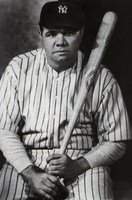 4) The curse must run its course. There is no appeal. There are no short cuts. Blowing up the Chicago foul ball changes nothing. A curse is over when it is over.
4) The curse must run its course. There is no appeal. There are no short cuts. Blowing up the Chicago foul ball changes nothing. A curse is over when it is over.
5) At the root of every curse is an act of betrayal. It is hard to remember those halcyon days when Portland identified itself with its
It is hard to remember those halcyon days when Portland identified itself with its
basketball team with unconditional affection. The championship win of 1977 cemented a relationship that was sustained for well over a decade. In the early 1990’s the fans bond with the Drexler, Porter, Kersey, Williams, Duckworth, Robinson & Ainge team coached by Rick Adelman, was stronger than ever. A sell-out streak at Memorial Coliseum stretched back to 1977. Glasses with the likenesses of individual players flew out of the Dairy Queens across the state. Fans of the team shared a common slang, a lingua franca based on the obtuse sayings of Blazer announce Bill Schonely. The team was “Red hot n’ rollin,’" a well executed combination was described: “Bingo, Bango, Bongo!” and a truly transcendent play was followed by the exclamation: “Rip City!”
What did it all mean? No one could say, but everybody knew.
In this era of sackcloth & ashes, it behooves us to ask, where did it all go wrong? At what moment did the balance tip? What small pebble of transgression lead to the avalanche of woe? At what point did the Trail Blazers become cursed?
In 1991, a new venture opened at 3100 NE Sandy, the Rip City Diner.
It seems odd, even quaint now that a business would choose a name so associated with the Portland Trail Blazers. Today’s Blazers would probably react to it like a lost man in a desert to a glass of water, but the front office of 1991 responded in a very different way. They threatened to sue. Siting trademark protection, they demanded the restaurant and a small T-shirt company to cease using the Rip City name.
The reaction in Portland was instantaneous and unanimous. To use a term now very familiar, the fans were up in arms. A corporate bully was coming down on the little guy.
"Of course you may wonder why a multimillioin-dollar enterprise like the Trail Blazers is going around stamping out fans as if they were just a bunch of annoying bugs. But, hey, business is business."-Phil Sanford, the Oregonian
They didn’t even have a good case. The argument; that the phrases “Rip City” and “Red Hot N’ Rollin’ ”were common law trademarks was murky at best. And the controversy could not have come at a worse time. The Blazers were in a Western Conference championship series against the LA Lakers. They were also at the beginning of negotiations with the city for a new and larger arena. At the moment the civically cautious citizens of Portland were being asked to pony up money to replace Memorial Coliseum, the team chose to act like a big-market stranger.
For over a week, newspapers, radio and television took turns taking swings at the story. Finally the team backed down.
 "I did not realize that Portland was so full of common people who know a rip-off when they see it."
"I did not realize that Portland was so full of common people who know a rip-off when they see it."
-Ron Amstrong, owner of the Rip City Diner.
3100 NE Sandy Blvd Today
But the damage had been done. The team had asserted they owned what than fans had believed that they had shared. From that point on, things would never be quite the same.
Thus began the Curse. The venom was slow spreading but exponential in its progress. The following year the Blazers lost to the Chicago Bulls in the finals. Within two years Rick Adelmen would be fired as head coach, by that time the hugely popular early nineties team was largely dismantled.
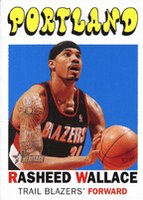 On July 12,1994, a black day for Portland sports, “Trader Bob” Whitsett was hired as the Blazers President and General Manager. In 1995 the Rose Garden was completed but the promised thriving commercial district to accompany it was no where to be seen. On November 20th 1995 the sell out streak ended after 814 games. Shortly thereafter Rasheed “Cut the Check” Wallace joined the team.
On July 12,1994, a black day for Portland sports, “Trader Bob” Whitsett was hired as the Blazers President and General Manager. In 1995 the Rose Garden was completed but the promised thriving commercial district to accompany it was no where to be seen. On November 20th 1995 the sell out streak ended after 814 games. Shortly thereafter Rasheed “Cut the Check” Wallace joined the team.
Isaiah Rider ushered in the beginning of the “Jail Blazer” era in with his 1996 acquisition. The following year, he would be suspended by the NBA three games for spitting on a fan in Detroit. Then, in a extremely ill advised affront to the faithful, Bill Shonely was replaced by Brian Wheeler as the Blazers radio play by play announcer. Other teams (like the LA Lakers with Chick Hearn, and the Chicago Cubs with Harry Caray) kept their beloved long-time announcers for life, but not Portland. Thus “Bingo, Bango, Bongo!” gave way to “Boom-Shakalaka!” and the sound of radios being turned off statewide.
 “Lickity brindle through the cyclops.”
“Lickity brindle through the cyclops.”
–Bill Shonely.
June 4th 2000. The Blazers had trailed Lakers three games to one in the Western Conference finals. Incredibly they won the next two games to force a deciding game seven of the series. At the end of three quarters the Portland lead the Lakers 71 to 58, and were on the verge of becoming just the seventh team in NBA history to battle back from a 3-1 series deficit. Then, in the forth quarter, the Lakers went on a 15-0 shooting spree to knock out the Blazers 89-84. It was a stunning collapse. The Lakers went on to win the NBA championship.
“In just ten magnificent minutes, the team that almost blew it all mounted the greatest forth quarter comeback ever in a game 7.” -Sports Illustrated.
Brian Grant, the most popular Blazer in years was traded in a deal that brought rotund walking paternity suit Shawn Kemp to the team. Rasheed Wallace and Damon Stoudamire were busted for possession of marijuana driving back to Portland after a game in Seattle. Stoudamire had already been charged with having a large amount of marijuana in his Lake Oswego home. Later he would be arrested in a Tuscon Arizona airport for possession. And then… Ladies and Gentlemen, Mr. Bonzi Wells:
"We're not really going to worry about what the hell [the fans] think about us," Wells says. "They really don't matter to us. They can boo us every day, but they're still going to ask for our autographs if they see us on the street. That's why they're fans and we're NBA players."- Bonzi Wells in Sports Illustrated.
"And I want to be a new Bonzi. From this year on, I am going to make strides.” -Bonzi Wells, September 23 2003 in the Portland Tribune.
Q: Did you flip off a fan, Bonzi?
A: “I don't remember nothing like that, but if I did, I was probably wrong. But I don't remember doing nothing like that. I black out sometimes”. -Bonzi Wells, November 10 2003 in the Oregonian.
Ruben Patterson was arrested for domestic assault, then Zach Randolf was suspended for punching Rubin Patterson in the face during practice.  Rasheed Wallace was traded and instantly won a NBA Championship ring with the Detroit Pistons.
Rasheed Wallace was traded and instantly won a NBA Championship ring with the Detroit Pistons.
The Oregon Arena Corporation declared bankruptcy February 8th 2004, and the Rose Garden was taken by a group of its creditors.
The Curse took a particularly morbid and shameful turn when Qyntel Woods was waved by the team for participation in a dog fighting ring after being seen dumping a wounded dog off in an ally.
Midway through the unspectacular 2004-2005 season coach Maurice Cheeks was fired.
Cucina Cucina, the last of three restaurants in the Rose Quarter closed. Could an urban renewal district be far behind?
Nate McMillan was hired from Seattle to coach the team, by all accounts a good move, but the team continued to lose. And lose. And lose. Sebastian Telfair, who the team was marketing as the second coming of Richie Cunningham gets a two game suspension for having a loaded gun on board the team plane.

Finally, the owner, (a billionaire), asked the City of Portland (with a massive school budget shortfall) for financial assistance.
This is a curse awe-inspiring in its scope and ferocity.
Diagnosis is not a cure, but maybe this can serve as a cautionary tale.
The non-superstitious will discount the very notion of a curse in a rational universe. Perhaps.
But if sports curses do exist, it is hard to argue the Blazers are not under one, or that a shift in fortune can be traced to 1991, when the Portland Trail Blazers first bit the hand that fed them.

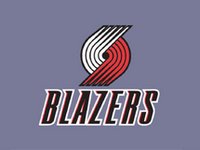 3100
3100

 Despite its spatial limitations, the park is remarkably true to the vision described by landscape designer Herbert Dreiseitl in the early presentations.
Despite its spatial limitations, the park is remarkably true to the vision described by landscape designer Herbert Dreiseitl in the early presentations.
 The area around NW 9th and Lovejoy: From the old Lovejoy viaduct in 1995 and street level in 2006.
The area around NW 9th and Lovejoy: From the old Lovejoy viaduct in 1995 and street level in 2006. In this 1852 map, Tanner Creek meets the road from the Tualatin Plains west of town, then flows northeast towards Couch Lake and the Willamette River.
In this 1852 map, Tanner Creek meets the road from the Tualatin Plains west of town, then flows northeast towards Couch Lake and the Willamette River.
 The same location, in 1994 and 2006.
The same location, in 1994 and 2006. Tanner Spring.
Tanner Spring.
 This year the park will have its first spring. It will be interesting to see if the “wild” areas will become more so. I hope they do.
This year the park will have its first spring. It will be interesting to see if the “wild” areas will become more so. I hope they do.
 The Portland Streetcar passes the park at NW 10th and NW Northrup.
The Portland Streetcar passes the park at NW 10th and NW Northrup.

 On the site of Hoyt Street Yard, 2006.
On the site of Hoyt Street Yard, 2006. Spokane, Portland & Seattle Railway's Hoyt Street Yards in the early 1940s. The present location of the park is in the right corner of the photograph.
Spokane, Portland & Seattle Railway's Hoyt Street Yards in the early 1940s. The present location of the park is in the right corner of the photograph. In Remembrance of the Lost Wetland" Aritst Herbert Dreiseitl.
In Remembrance of the Lost Wetland" Aritst Herbert Dreiseitl.









